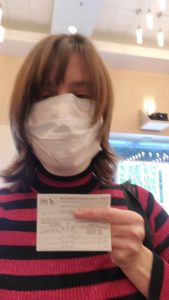 A special hello to Dr. Diana Taft, Assistant Professor of Nutritional Sciences in the Food Science and Human Nutrition Department at the University of Florida! Dr. Taft’s research focuses on the infant microbiome and resistome. In this article, learn more about the essential connection between microbes and our health, the new classes she teaches, and the three foods she would bring to a deserted desert island!
A special hello to Dr. Diana Taft, Assistant Professor of Nutritional Sciences in the Food Science and Human Nutrition Department at the University of Florida! Dr. Taft’s research focuses on the infant microbiome and resistome. In this article, learn more about the essential connection between microbes and our health, the new classes she teaches, and the three foods she would bring to a deserted desert island!
How did you become interested in studying the development of the term infant microbiome and resistome?
When I started graduate school in 2009, the NIH Human Microbiome Project was just starting to publish. My mentor at the University of Cincinnati, Dr. Ardythe Morrow, was just starting a preterm infant cohort with the goal of looking for gut microbiome markers of necrotizing enterocolitis.
The microbiome is all the microbes that live in or on a specific environment. So the preterm infant gut microbiome would be all the microbes living in a preterm infant gut. I was fascinated to learn that microbes were not just harmless passengers or dangerous pathogens, but were also essential for human health. I was quickly hooked on the idea of studying the bacteria critical for human health.

Tell me more about how you decided to focus on the microbiome and resistome.
After finishing my degree, I thought I wanted to move more in the direction of immunology. During my postdoctoral research in immunology, I realized I was still in love with the gut microbiome. If I really wanted to study the gut microbiome, I needed more microbiology experience. So I did a second postdoctoral position with Dr. David Mills at the University of California, Davis (UC Davis).
This time, my work focused on term infants and the role of Bifidobacterium in reducing infant carriage of antimicrobial resistance genes. Antimicrobial resistance genes are the genes that microbes–like bacteria–carry that allow them to survive when they encounter antimicrobial agents. When you hear on the news about antibiotics failing to treat diseases they used to cure (i.e., antibiotic-resistant bacteria), the reason is that the pathogen causing the disease has acquired antimicrobial resistance genes.
The infant resistome refers to all antimicrobial resistance genes carried by an infant. Because bacteria can share many antimicrobial resistance genes with other species of bacteria, the more antimicrobial resistance genes found in the microbiome, the higher the chance that a gene might pass to a pathogen. And it turns out that infants carry a lot of antimicrobial resistance genes, even more than adults! Because the infant microbiome is heavily influenced by diet, there is a chance that diet can be used to control the infant resistome.

Would you share some of the recent projects you are working on?
I just submitted a grant focused on how early life environment and infant feeding (either exclusively human breastmilk, a mix of breastmilk and formula, or exclusively formula) shape the development of the infant resistome. If funded, this grant would help to answer questions such as: do infants whose mothers received antibiotics during delivery carry more resistance genes than infants whose mothers don’t receive antibiotics? Does exclusive breastfeeding change the number of resistance genes that remain in the infant gut microbiome?
I also just finished rewriting a paper comparing infant carriage of different species of Bifidobacterium in countries around the world. My key finding is that historical breastfeeding practices in a population heavily influence the species of Bifidobacterium that can be found in a population.

Tell me about the classes you teach.
This fall, I will teach an in-person introductory biochemistry course for non-pre-health undergraduate students. The FSHN Department already teaches a version of this course online. Therefore, this will be a supplement for students who don’t need or want to take the pre-health biochemistry but would prefer an in-person learning environment. I also plan to teach a graduate-level data-analysis course in the spring, but planning for that course is in the early stages. I will teach the graduate-level carbohydrate course in alternate spring semesters from the data-analysis course.
What do you believe is the most important fact the public should know about the microbiome?
That the infant gut microbiome is actually very different from the adult microbiome! Because babies are fed a very different diet than what adults eat, the microbes that colonize a baby are not the same as those in an adult. As a bonus, it’s easier to change the microbiome of a baby than an adult. Instead of trying to fix a problematic adult microbiome with probiotics and prebiotics, we should focus on making sure that infants acquire bacterial species important for health early when it’s easier for new species to become part of the microbiome.

What do you like to do in your free time?
I like to read. For exercise, I ice skate and rock climb. But with the nearest ice rink in Jacksonville, I think I will need a new activity soon! I also like to do craft projects. At the moment, I am working on a needlepoint project.
If you were stuck on a desert island, what three foods would you bring with you?
I’m going to cheat a little in my answer and go with pizza as my first choice. Pizza is a very flexible food and including it suggests all sorts of possible toppings. But not pineapple – I do not like pineapple on pizza. I do like a variety of other toppings, including pepperoni, chicken, spinach, onion, garlic, basil, oregano, sweet potato (better than it sounds!), broccoli, etc. Changing toppings would create some variety. My second choice would be hot chocolate, and my third choice would be chicken soup. I’d choose hot chocolate because I love chocolate and wouldn’t want to miss out, while chicken soup is my go-to comfort food.

Interested in learning more about FSHN’s Nutritional Sciences programs? Read more here and here and here!
P.S. The Discover FSHN Series highlights the unique experiences of UF’s Food Science and Human Nutrition students, faculty, staff, and alumni. Want to read more about the amazing work going on in the FSHN department? See our previous features below:
Undergraduate Students:
Shannon Mai, Dietetics
Alex Colon, Dietetics and Jenny Duong, Food Science
Jackie Shannon, Nutritional Sciences
Jennifer Jordan, Food Science
Lily Tucciarone, Dietetics
Tim Cassella, Nutritional Sciences
Graduate Students:
Savanna Curtis, Food Science (M.S.)
Carley Rusch and Matthew Beke, Nutritional Sciences (Ph.D.)
Alexa Hosey, Dietetics (MS/DI)
Vicnie Leandre, Food Science (M.S.)
Rufus Theophilus, Nutritional Sciences (Ph.D.)
Amber Fritsche, Dietetics (MS/DI)
Amy Jones, Food Science (Ph.D.)
Melissa Perez Santana, Food Science (M.S.)
Postdoctoral Associates:
Dr. Cameron Bardsley, Food Safety
Dr. Tautvydas Shuipys, Food Safety
Faculty:
Dr. Naim Montazeri, Food Science/Food Virology
Dr. Jeanette Andrade, Dietetics
Dr. Zhiyong Cheng, Nutritional Sciences
Dr. Juan Andrade Laborde, Global Nutrition
Dr. Razieh Farzad, Food Science
Dr. Beth Gankofskie, Dietetics
Dr. Anne Mathews, Nutritional Sciences
Staff:
Sharyn Passeretti, Lab Specialist
Herschel Johnson, Manager of Student Services
Brandy Johnson, Administrative Assistant
Alumni:
Dr. Rebecca Gould, Dietetics, Postdoctoral Research
Dr. Becca Solch, Nutritional Sciences, Postdoctoral Research
Hannah Cooper, Dietetics, Private Practice
Dr. Richie Li, Food Science, Product Development
Doctor Brian Barrow, Nutritional Sciences, Medicine/Physician
Luciano Junoy, Food Science, Product Development
P.P.S. Learn more about FSHN’s renowned programs below!
Undergraduate Programs:
Dietetics
Food Science
Nutritional Sciences
Graduate Programs:
M.S. Dietetic Internship Program
M.S. Food Science and Human Nutrition
Ph.D. Food Science
Ph.D. Nutritional Sciences
 1
1
